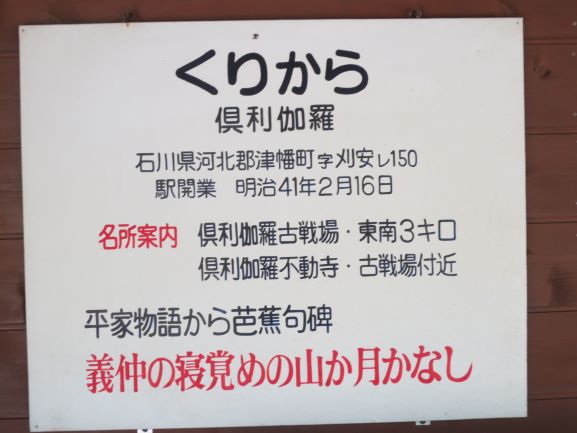1-2 万葉公園と芭蕉句碑 Manyo Park and Basho haiku monument
<万葉公園> Manyo Park
富山県と石川県の県境にある倶利伽羅峠、富山県側から峠へむかう坂道の途中に万葉公園がある。
大伴家持と大伴池主が詠んだ歌37首が5基の碑に刻まれている。家持と池主の温かな親交が歌から読み取れる。
長歌がほとんどで、一部を抜粋して刻まれている。
There is a Manyo Park in the middle of the slope leading to the pass from Toyama Prefecture, which is located on the border between Toyama and Ishikawa Prefectures. There are five monuments inscribed with 37 poems written by Otomo no Yakamochi and Otomo no Ikenushi. The warm friendship between Yakamochi and Ikenushi can be read from the poems. Most of the poems are long, but some are excerpted and inscribed.
<芭蕉句碑> Basho haiku monument
芭蕉句碑は倶利伽羅峠に位置しています。松尾芭蕉が当地を訪れたのは1689年であり、奥の細道行脚の折、北陸道を利用し倶利伽羅峠を通過しました。この時の様子が随伴者で弟子である曽良がしたためた日記に記載されています。案内板によると松尾芭蕉が弟子の曽良と共にこの地を通ったのは元禄2年7月15日の朝でした。
芭蕉が朝日将軍とうたわれた木曽義仲の末路を涙して詠んだのが次の句である。「義仲の 寝覚め山か 月かなし」
Basho’s haiku monument is located at the Kurikara Pass. Matsuo Basho visited this area in 1689, when he took the Hokuriku Road and passed through the Kurikara Pass on his way of the Okuno Hosomichi. He was accompanied by his disciple, Sora, who wrote a diary of his visit. According to the information board, Matsuo Basho and his disciple Sora passed through this area on the morning of July 15, Genroku 2. Basho wrote the following poem in tears about the end of Kiso Yoshinaka, who was known as the Asahi Shogun. “Yoshinaka no Nezameyamaka Tsukikanasi.”


